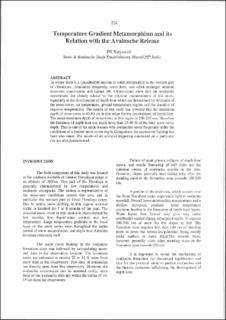| dc.contributor.author | Satyawali, P. K. | |
| dc.contributor.editor | Hestnes, Erik | |
| dc.date.accessioned | 2023-08-04T11:37:46Z | |
| dc.date.available | 2023-08-04T11:37:46Z | |
| dc.date.issued | 1998 | |
| dc.identifier.isbn | 82-546-0184-4 | |
| dc.identifier.issn | 0078-1193 | |
| dc.identifier.uri | https://hdl.handle.net/11250/3082650 | |
| dc.description.abstract | In winter there is a considerable amount of solid precipitation in the western part of Himalayas. Avalanche frequently occur here, and often endanger national economic construction and human life. Observations show that the avalanche occurrences are closely related to the physical characteristics of the snow, especially to the development of depth hoar which are determined by thickness of the snow cover, air temperature, ground temperature regime and the duration of negative temperatures. The results of this study has revealed that the maximum depth of snow cover is 40-60 cm in this range for the development of depth hoar. The mean maximum depth of snow cover in this region is 200-225 cm. Therefore the thickness of depth hoar can reach more than 25-30 % of the total snow cover depth. That is one of the main reasons why avalanches occur frequently under the conditions of a limited snow cover depth. Comparison for snowcover buildup has been also made. The results of an artificial triggering conducted on a particular site are also demonstrated. | en_US |
| dc.language.iso | eng | en_US |
| dc.publisher | Norwegian Geotechnical Institute | en_US |
| dc.relation.ispartofseries | NGI Publication;203 | |
| dc.subject | Snow Avalanche | en_US |
| dc.subject | History | en_US |
| dc.subject | Avalanche-RnD | en_US |
| dc.subject | Snøskred-FoU | en_US |
| dc.title | Temperature gradient metamorphism and its relation with the avalanche release | en_US |
| dc.type | Chapter | en_US |
| dc.source.pagenumber | 224-228 | en_US |
